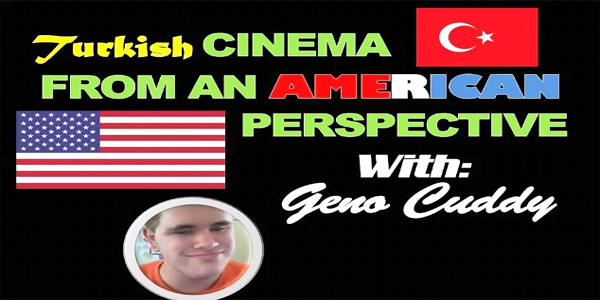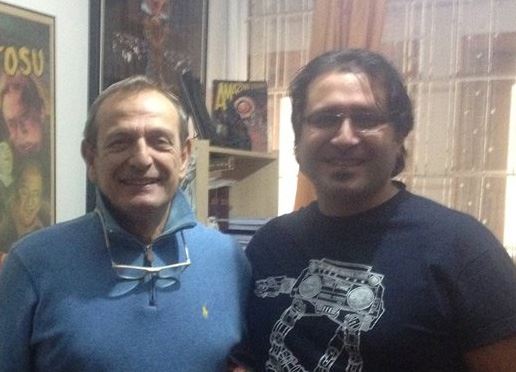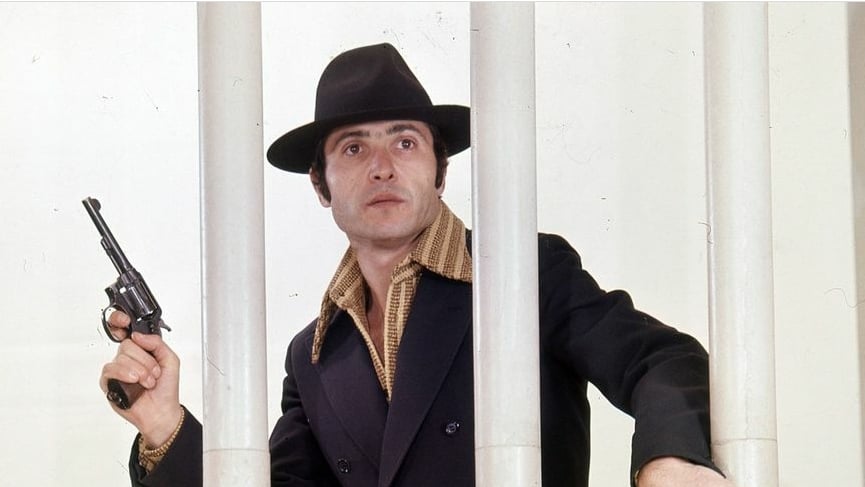We wellcome a brand new section in Sinematik Yeşilçam: Turkish Cinema from an American Perspective.
And here comes Geno Cuddy’s first Video Review for Sinematik Yeşilçam. Geno explains his first video preview:
“Here is my review of “Dunyayi Kurtaran Adam”, I decided to do a video review of the film, because I had many epiphanies while watching the film, and I got into a deep analysis of the film.“
Here is the Video:
Geno Cuddy’s review no.1 – DUNYAYI KURTARAN ADAM from Sinematik Yeşilçam on Vimeo.
And here is the transcript first review.
DÜNYAYI KURTARAN ADAM
Reviewed and Analyzed by GENO CUDDY
 Hello Sinematik Yeşilçam, this is Geno Cuddy and welcome to “Turkish Cinema from an American Perspective”, this is a new column that I have started in association with Utku Uluer, the editor and administrator of the website. This will be an English section of the site for fans of Turkish cinema, who don’t understand the Turkish language, that can find out more about Turkish cinema and can read or hear reviews of popular Turkish films in their own language. We may work someday on expanding it to other national languages, but for now we will utilize the English language.
Hello Sinematik Yeşilçam, this is Geno Cuddy and welcome to “Turkish Cinema from an American Perspective”, this is a new column that I have started in association with Utku Uluer, the editor and administrator of the website. This will be an English section of the site for fans of Turkish cinema, who don’t understand the Turkish language, that can find out more about Turkish cinema and can read or hear reviews of popular Turkish films in their own language. We may work someday on expanding it to other national languages, but for now we will utilize the English language.
Today’s review is going to be of the 1982 film Dünyayı Kurtaran Adam (The Man Who Saved the World). The film has been improperly referred to as the Turkish Star Wars, because of the constant use of footage from the 1977 film Star Wars or as it is known Star Wars Episode 4: A New Hope. The use of the Star Wars footage is non-essential to the plot, really. The use of the Star Wars footage was really used as a cost-cutting measure, because, and I was told this by Utku himself, that the original plan was to build a spaceship, and work had started of said spaceship, however there was a mighty sandstorm and the ship was blown away.
So Kunt Tulgar, who was a film distributor in Turkey at the time, had acquired footage of the aforementioned Star Wars film. So director Çetin İnanç, decided to use the footage in his film. Çetin İnanç was referred to as a “Jet Director”, because he was well known for shooting his films at a very rapid pace and they were mostly finished in under ten days. In addition to the footage from Star Wars, there is music used from American films as well, for example the main theme from the Indiana Jones epic Raiders of the Lost Ark, Disney’s The Black Hole, and the James Bond film Moonraker, which was the James Bond film set in space. Other music used was the Giorgio Moroder rendition of the Battlestar Galactica theme.
The film, again, has been referred to, in America, as the Turkish Star Wars; however the film’s plot is really not a Star Wars story. It uses the footage, and some light overtones, from the 1977 film, but it has no connection, nor is it derivative of any of the Star Wars films. The Man Who Saved the World, really takes it’s plot and certain characters and traits, from many famous science fiction films, those films are, of course, Star Wars, the 1980s Flash Gordon film, and to a certain extent, the 1927 film Metropolis, and I will state why later in my analysis.
The villainous wizard in the film, portrayed by Hikmet Taşdemir, who mostly played villains in many of Cüneyt Arkın’s films, was inspired by Ming the Merciless, the main villain from the aforementioned Flash Gordon film. In fact, in certain scenes in the film, you can hear Max von Sydow’s (the man who played Ming) laugh being used whenever the Wizard enters or exits a scene. His robotic assistant’s immediate ancestor can easily be identified as Robby the Robot from the film Forbidden Planet from 1957. The spacesuits worn by Murat and Ali (Cüneyt Arkın and Aytekin Akkaya respectively) were inspired by the spacesuits used in the Flash Gordon serials of the 1930s and 1940s.
 Now onto my analysis of the film. Ali (Akkaya) seeks the love of a woman, and throughout the film, he discusses women. In the opening scene, where he and Murat (Arkın) are battling mysterious forces in vast space, he is quoted as saying “Those guys are too sour faced, I wish some girls in miniskirts would come by”, and when they crash land on the planet, his wolf whistle, which is, apparently, the world-known #1 seducer of women is used. Ali seems to think that he has landed on a planet of all women, which is one of his many sexual fantasies. Aytekin Akkaya, himself, explained sexual fantasies in Turkish cinema in the Mondo Macabro documentary on Turkish “Pop Cinema”
Now onto my analysis of the film. Ali (Akkaya) seeks the love of a woman, and throughout the film, he discusses women. In the opening scene, where he and Murat (Arkın) are battling mysterious forces in vast space, he is quoted as saying “Those guys are too sour faced, I wish some girls in miniskirts would come by”, and when they crash land on the planet, his wolf whistle, which is, apparently, the world-known #1 seducer of women is used. Ali seems to think that he has landed on a planet of all women, which is one of his many sexual fantasies. Aytekin Akkaya, himself, explained sexual fantasies in Turkish cinema in the Mondo Macabro documentary on Turkish “Pop Cinema”
QUOTE: “There was a sex problem. Young men couldn’t even hold a girl’s hand in public. So they were satisfying their sexual needs by watching sex scenes in the films and the cinemas were full again”.
The film also contains surrealist imagery, such as skeletons on horseback, albeit men in ill-fitting suits, but the very idea of skeletons riding on horseback is a very macabre and surrealistic idea, reaching from the minds of such artists as Salvador Dalí and Man Ray. More macabre imagery follows after the first battle, as Murat and Ali ride their horses in through the countryside, we see many demons and monsters appear, albeit men in cheap masks, but they are demons nonetheless.
The Wizard, represents communism, there are oppressive conditions and he abuses the community of peasants. The “Raider’s March”, the popular Indiana Jones theme, is used to illustrate heroism, good deeds and feats of strength. The Wizards hunger for blood, suggests a connection or association with Vlad Tepes, a Romanian tyrant, who was the inspiration of Bram Stoker’s Dracula.
 The mute girl, portrayed by Füsun Uçar, represents innocence and a virgin saint, she has never seen heroism as exhibited by Murat, and she has never felt the love of a man, she is abused by and confused about mankind. In the cave scene, Murat says “Oppression has never known laughter”, and when Ali laughs, the confusion shows on the faces of the peasants. The elder, played by Huseyin Peyda, reminisces about more peaceful times on Earth, and Murat and Ali start piecing together the reason as to why they crash landed on the planet, the elder warns about demons invading as a result of tyranny.
The mute girl, portrayed by Füsun Uçar, represents innocence and a virgin saint, she has never seen heroism as exhibited by Murat, and she has never felt the love of a man, she is abused by and confused about mankind. In the cave scene, Murat says “Oppression has never known laughter”, and when Ali laughs, the confusion shows on the faces of the peasants. The elder, played by Huseyin Peyda, reminisces about more peaceful times on Earth, and Murat and Ali start piecing together the reason as to why they crash landed on the planet, the elder warns about demons invading as a result of tyranny.
The mummies in the film represent ancient evil, and the other monsters suggest contemporary struggles to survive. Not only are the peasants victims of the Wizard but of surrounding evil. The clawed werewolf/nosferatu hybrid creature suggests bloodlust, and he is seen as a possible, savage descendant of Star Wars’ Chewbacca. Death by evil turns one into an evil creature, as seen when the dead in the tomb transform into creatures of the undead. The Wizard’s vampirism continues as he drinks the hellish elixir of life.
The training scene, in which Murat and Ali punch rocks represents the battle for ultimate power, they are not only showing off brute force, but rocks represent solid and unbreakable evil, so Murat and Ali are further penetrating the forced of evil by destroying an embodiment of it. There is also at this time, romance pulsating through the mute woman, through her smiles we can see a trust building between her and Murat, a romantic bond, if you will. The orphaned boy looks upon Murat and Ali as father figures, he is amazed at their strength and athleticism, he learns about inner strength by witnessing Murat’s herculean power at work.
 Murat, tying rocks to his ankles, represents how the weight of the world has been placed onto him, the rocks in this case represent two planets, his own and the one he crash landed on, they suggest Murat’s struggles to save this new world while saving his own. This idea shadows Luke Skywalker’s struggles in Star Wars. Murat is unable to escape his fate, as his jumping into the air and quickly plummeting down represents gravity, as he alone is the man to save the two worlds.
Murat, tying rocks to his ankles, represents how the weight of the world has been placed onto him, the rocks in this case represent two planets, his own and the one he crash landed on, they suggest Murat’s struggles to save this new world while saving his own. This idea shadows Luke Skywalker’s struggles in Star Wars. Murat is unable to escape his fate, as his jumping into the air and quickly plummeting down represents gravity, as he alone is the man to save the two worlds.
Murat’s jumping and feats of strength, suggest him to be a God-like figure, able to jump higher and fight harder than most men, this enforces the idea of Greek mythology, and Murat symbolizes the Greek God Hercules. The mute woman relies on Murat, and cannot function without him; she can’t survive without the love of a man. Further abuse upon the innocent is inflicted in the restaurant scene, provoking Murat and Ali to fight against injustice.
The Wizard in addition to representing a vampire also represents Lucifer or a Beelzebub, a satanic figure, a figure from Hell’s womb, his magic is evil and he appears to have sprung from Belial’s Seed. Further reinforcing this is his use of a red shield, red is not only the color representation of the underworld, but is the color of the hellish elixir of life…BLOOD. The Wizard’s repeated use of the mute girl and boy represents Murat’s struggle to not only protect freedom, but family as well, as the mute girl is depicted as being Murat’s wife and the boy is depicted as his son.
The Queen, portrayed by Necla Fide, suggests Ali’s sexual fantasies being realized. She, herself, embodies an ancient figure from biblical times, the Whore of Babylon, the perfect but unobtainable woman; her advances reinforce her as such, and she disappears before intercourse can take place. The Wizard uses his mask to hide his mortality; he is human at heart, so this is why he is only seen without it in his lair, where he is vulnerable, he cannot leave his lair and enter the outside world without it, further reinforcing the idea of him representing a vampire, as vampire mask themselves from the outside world a ’la Nosferatu.
Lastly the wizard’s golden brain represents one voice, the voice of tyranny, but he needs to brains to achieve full power as government needs two voices in order to function. Murat’s golden brain that he receives later on in the film represents the other voice, the voice of democracy, which he melts along with the mystical sword to form gauntlets of democracy and freedom, Murat can now literally fight tyranny.
 I see the film, The Man Who Saved the World, as subtle propaganda. The film is loosely inspired by Metropolis, in that both films discuss the idea of a tyrannical government through the science fiction film genre. The Wizard is depicted as the ruler of the kingdom, and the monsters that Murat and Ali fight are seen as the congress or the senate. Most people when viewing this film see it mainly as a goofy science fiction film, but with more viewings the depth of the film becomes clearer. It is not just a science fiction film, but subtle anti-Nazi propaganda. I have no idea, and I would have to consult Utku on this, if Cüneyt Arkın and Çetin İnanç were against the government, during this time, because if they were this film could be seen as satire of the government in Turkey at the time. As I stated before, the Wizard is the king of the land, the president, the dictator if you will. His monsters, his henchmen, are members of the congress or the senate in American terms. So this film is literally a film with a message, which is that the overwhelming power of communism can be toppled by one person as exhibited when Cüneyt Arkın’s character Murat in the film. Turkish Cinema
I see the film, The Man Who Saved the World, as subtle propaganda. The film is loosely inspired by Metropolis, in that both films discuss the idea of a tyrannical government through the science fiction film genre. The Wizard is depicted as the ruler of the kingdom, and the monsters that Murat and Ali fight are seen as the congress or the senate. Most people when viewing this film see it mainly as a goofy science fiction film, but with more viewings the depth of the film becomes clearer. It is not just a science fiction film, but subtle anti-Nazi propaganda. I have no idea, and I would have to consult Utku on this, if Cüneyt Arkın and Çetin İnanç were against the government, during this time, because if they were this film could be seen as satire of the government in Turkey at the time. As I stated before, the Wizard is the king of the land, the president, the dictator if you will. His monsters, his henchmen, are members of the congress or the senate in American terms. So this film is literally a film with a message, which is that the overwhelming power of communism can be toppled by one person as exhibited when Cüneyt Arkın’s character Murat in the film. Turkish Cinema
I was informed by Utku, that many Turkish audiences themselves find the film to be quite laughable, for the longest time I did as well, but as I was watching it and writing my notes, I realized what the film truly represents and hopefully the audience who has heard or read this review now understand my take on the film. Thank you for reading and listening to this deep analysis and review of the film, which on a technical level, is not very well done, the editing is haphazard, especially during the finale of the film. But when all is said and done, if you can get past its flaws, it is a powerful film with a message, and I insist you check it out for yourself. Thank you for reading this review, there will be more to come.
Turkish Cinema














